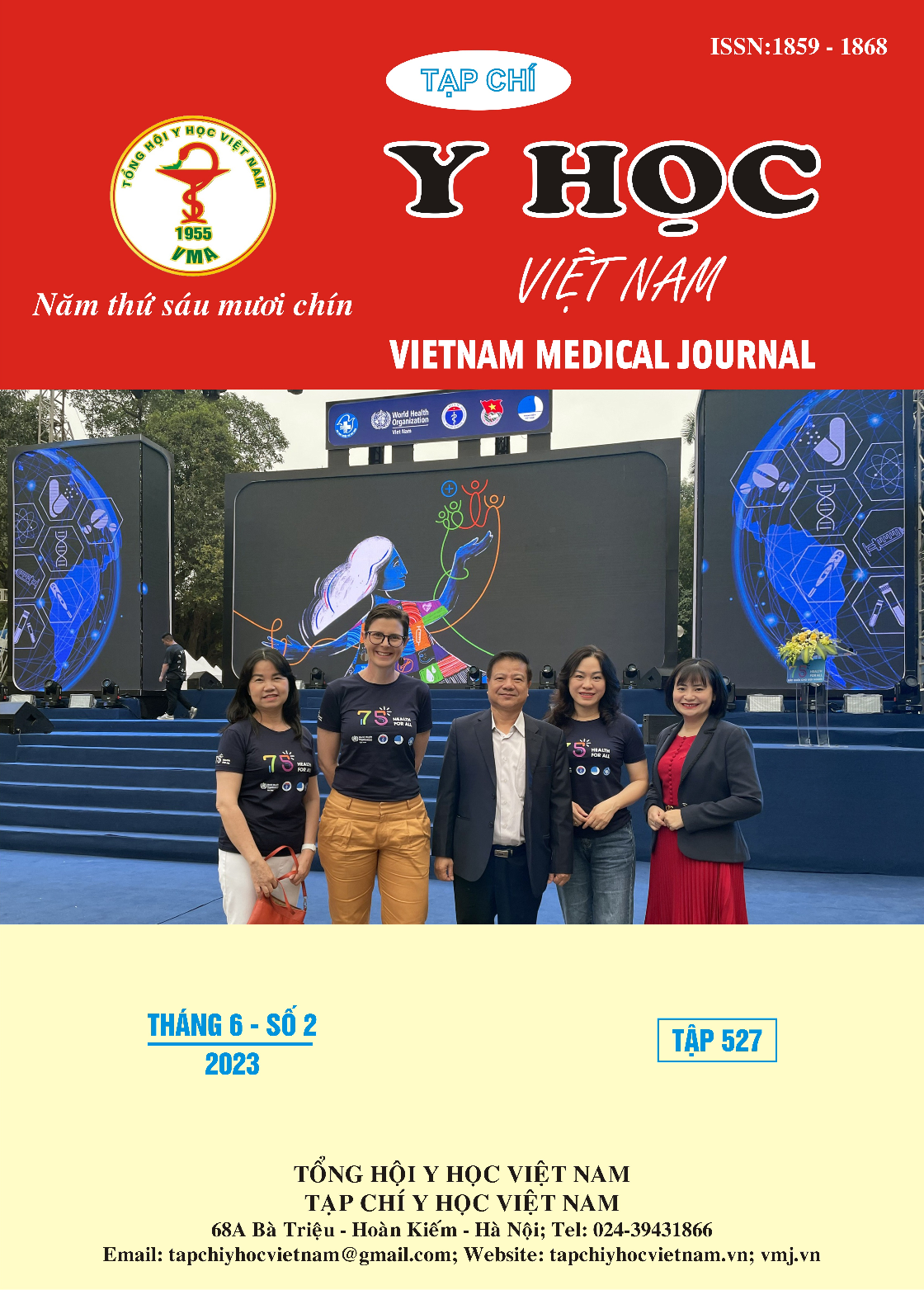KHẢO SÁT BIẾN ĐỔI NỒNG ĐỘ OSTEOPROTEGERIN HUYẾT TƯƠNG Ở BỆNH NHÂN SAU GHÉP THẬN
Nội dung chính của bài viết
Tóm tắt
osteoprotegerin huyết tương (OPG) và mối liên quan với một số đặc điểm bệnh nhân sau ghép thận 6 tháng. Đối tượng: Đối tượng nghiên cứu gồm 164 người, chia làm 2 nhóm: 84 bệnh nhân trước ghép được theo dõi sau điều trị 6 tháng và 80 người khỏe mạnh ở nhóm chứng. Tất cả các bệnh nhân đều được định lượng nồng độ OPG huyết tương bằng phương pháp ELISA. Kết quả: Sau 6 tháng ghép thận tỷ lệ tăng ure là 15,5% và tăng creatinin là 36,9%. Có 31% số bệnh nhân giảm mức lọc cầu thận <60ml/p trong khi protein niệu sau ghép chỉ có 2 bệnh nhân (2,4%). Sau ghép các chỉ số được cải thiện là tình trạng thiếu máu, yếu tố viêm CRP so với trước ghép có ý nghĩa với p<0,05. Các yếu tố khác vẫn chiếm tỷ lệ cao sau ghép: Tăng huyết áp (66,7%), rối loạn lipid máu (67,1%). Có 2 bệnh nhân (2,4%) mắc đái tháo đường sau ghép. Nồng độ OPG trung bình ở bệnh nhân sau 6 tháng ghép thận là 10,2 pmol/L giảm so với trước ghép thận là 56,25 pmol/L sự khác biệt có ý nghĩa với p<0,001. Tỷ lệ bệnh nhân giảm nồng độ OPG là 39,3%, và nồng độ OPG còn cao là 60,7%. Chỉ số sinh xơ vữa động mạch AIP ở nhóm có nồng độ OPG giảm về bình thường thấp hơn nhóm có nồng độ OPG còn cao sau ghép có ý nghĩa với p<0,05. Kết luận: Nồng độ OPG ở bệnh nhân sau ghép thận 6 tháng giảm so với trước ghép thận, có ý nghĩa với p<0,001. Tỷ lệ bệnh nhân có nồng độ OPG giảm là 39,3%, và nồng độ OPG còn cao là 60,7%. Chỉ số sinh xơ vữa động mạch AIP ở nhóm có nồng độ OPG giảm về bình thường thấp hơn nhóm có nồng độ OPG còn cao sau ghép có ý nghĩa với p<0,05.
Chi tiết bài viết
Từ khóa
End stage chronic kidney disease, Osteoprotegerin, Atherosclerosis, Kidney transplant.
Tài liệu tham khảo
2. Akchurin O.M. (2019). Chronic kidney disease and dietary measures to improve outcomes. Pediatr Clin North Am, 66(1), 247–267.
3. Roumeliotis S., Mallamaci F., and Zoccali C. (2020). Endothelial Dysfunction in Chronic Kidney Disease, from Biology to Clinical Outcomes: A 2020 Update. J Clin Med, 9(8), 2359.
4. Kobiyama K. and Ley K. (2018). Atherosclerosis: A Chronic Inflammatory Disease with an Autoimmune Component. Circ Res, 123(10), 1118–1120.
5. Gupta V., Ekundayo O., Nemeth Z.K., et al. (2021). Association between serum osteoprotegerin level and mortality in kidney transplant recipients - a prospective observational cohort study. Transpl Int, 34(5), 844–854.
6. Kolonko A., Chudek J., Szotowska M., et al. (2016). Cardiovascular Risk Factors and Markers of Atherosclerosis in Stable Kidney Transplant Recipients. Transplantation Proceedings, 48(5), 1543–1550.
7. Nguyễn Thị Thu Hà (2022), Nghiên cứu kháng thể kháng HLA và mối liên quan đến đặc điểm lâm sàng và cận lâm sàng ở bệnh nhân ghép thận, Học viện Quân Y.
8. Krzanowski M., Krzanowska K., Dumnicka P., et al. (2018). Elevated Circulating Osteoprotegerin Levels in the Plasma of Hemodialyzed Patients With Severe Artery Calcification. Ther Apher Dial, 22(5), 519–529.
9. Chen Y.-C., Hsu B.-G., Ho C.-C., et al. (2017). Elevated serum osteoprotegerin may predict peripheral arterial disease after kidney transplantation: a single-center prospective cross-sectional study in Taiwan. PeerJ, 5, e3847.
10. Reggiani F., Moroni G., and Ponticelli C. (2022). Cardiovascular Risk after Kidney Transplantation: Causes and Current Approaches to a Relevant Burden. J Pers Med, 12(8), 1200.


